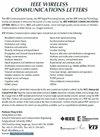RIS 辅助流体天线阵列无人机网络
IF 5.5
3区 计算机科学
Q1 COMPUTER SCIENCE, INFORMATION SYSTEMS
引用次数: 0
摘要
本文研究了具有流体天线(FA)的可重构智能表面(RIS)辅助自主飞行器(AAV)下行网络,其中RIS可实现非视距(NLoS)传输。此外,FA安装在AAV上,提供动态天线位置调整,除了AAV部署外,还增强了空间分集。我们的目标是总下行速率最大化,同时确保最低的用户速率要求。我们考虑了主动AAV波束形成、被动RIS波束形成、AAV部署和FA位置调整的联合优化。为了解决这个复杂的问题,我们提出了RIS/AAV和FA-AAV部署(BRAUD)方案的波束形成,通过对分解子问题采用替代优化、逐次凸逼近(SCA)和顺序第一约束松弛(SROCR)方法。仿真结果证明了RIS-FA-AAV的有效性,在没有FA/AAV/RIS部署和适当波束形成的情况下,在现有架构中实现了最高的速率。本文章由计算机程序翻译,如有差异,请以英文原文为准。
RIS-Aided Fluid Antenna Array-Mounted AAV Networks
This letter investigates reconfigurable intelligent surface (RIS)-assisted autonomous aerial vehicle (AAV) downlink networks with fluid antennas (FA), where RIS enables non-line-of-sight (NLoS) transmissions. Moreover, the FA is equipped on the AAV offering dynamic antenna position adjustment, enhancing spatial diversity besides AAV deployment. We aim at total downlink rate maximization while ensuring minimum user rate requirement. We consider joint optimization of active AAV beamforming, passive RIS beamforming, AAV deployment and FA position adjustment. To address the complex problem, we propose beamfomring for RIS/AAV and FA-AAV deployment (BRAUD) scheme by employing alternative optimization, successive convex approximation (SCA) and sequential rank-one constraint relaxation (SROCR) method for the decomposed subproblems. Simulation results demonstrate the effectiveness of RIS-FA-AAV, achieving the highest rate among existing architectures without FA/AAV/RIS deployment and without proper beamforming.
求助全文
通过发布文献求助,成功后即可免费获取论文全文。
去求助
来源期刊

IEEE Wireless Communications Letters
Engineering-Electrical and Electronic Engineering
CiteScore
12.30
自引率
6.30%
发文量
481
期刊介绍:
IEEE Wireless Communications Letters publishes short papers in a rapid publication cycle on advances in the state-of-the-art of wireless communications. Both theoretical contributions (including new techniques, concepts, and analyses) and practical contributions (including system experiments and prototypes, and new applications) are encouraged. This journal focuses on the physical layer and the link layer of wireless communication systems.
 求助内容:
求助内容: 应助结果提醒方式:
应助结果提醒方式:


